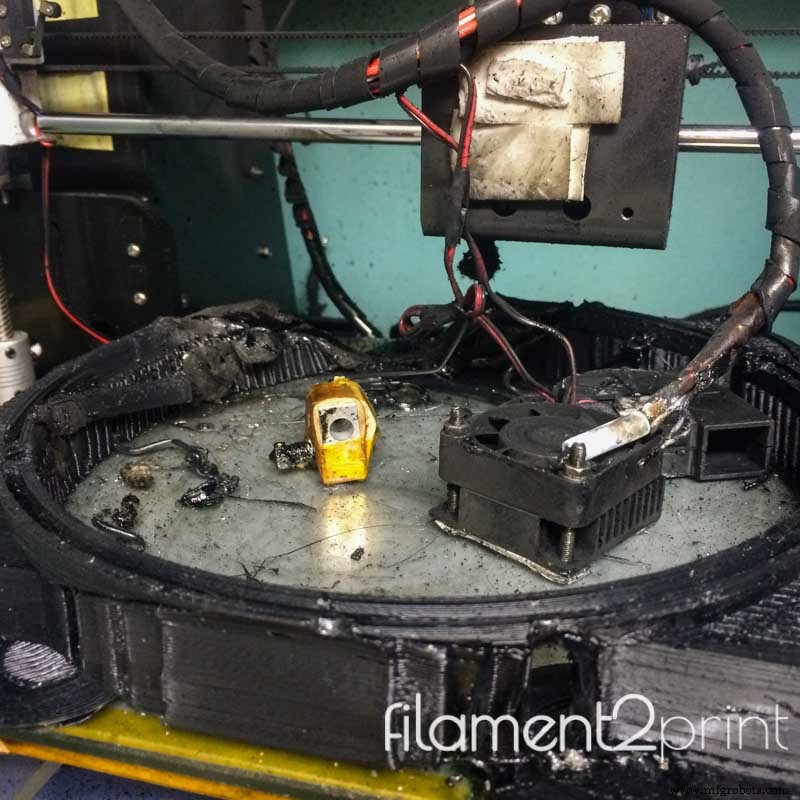Risiko saat mencetak dalam 3D

Setiap hari pencetakan 3D lebih tersebar luas baik di tingkat industri maupun di tingkat rumah tangga, sesuatu yang meningkatkan pengembangan banyak aplikasi dalam sejumlah besar bidang. Di tingkat media, hanya manfaat teknologi yang menonjol, tetapi ada tindakan pencegahan tertentu yang harus dilakukan diperhitungkan saat memulai dunia pencetakan 3D.
Tetapi setiap pengguna harus memperhitungkan risiko tertentu yang mungkin terjadi selama pencetakan 3D. Dua sumber utama risiko dan lebih umum adalah di satu sisi gas yang dilepaskan selama fusi material, dan di sisi lain kemungkinan sumber api karena penyalahgunaan printer 3D atau kondisi elektronik yang buruk.
Di bawah ini, kami merinci sumber utama risiko, serta tindakan pencegahan yang harus diambil untuk menghindari masalah besar:
Gas dan bau dilepaskan
Semua bahan yang digunakan dalam pencetakan FDM / FFF 3D adalah plastik atau mengandung sebagian dari bahan ini. Pada titik ini kami akan fokus pada tiga yang paling umum:PLA, ABS, dan HIPS.
ABS dan HIPS adalah dua materi yang sangat tersebar luas dalam pencetakan 3D dan juga, sangat umum untuk menggunakannya dalam kombinasi, HIPS sebagai bahan pendukung (dilarutkan dalam D-Limonene) dan ABS sebagai bahan dasarnya. Kedua bahan ini memiliki kekurangan yaitu selama peleburannya sejumlah stirena 20 kali lebih tinggi dari yang ada di atmosfer dilepaskan , menjadi karsinogenik dalam kasus respirasi berkepanjangan dari gas yang dipancarkan ini.
PLA adalah materi yang mudah dicetak pada printer 3D apa pun dan karenanya, yang paling serbaguna dari semua bahan yang ada untuk pencetakan 3D. Mengenai limbah yang dihasilkan, mengeluarkan laktida , elemen yang tidak menghadirkan masalah ABS yang disebutkan di atas, juga tidak memengaruhi kesehatan orang .
In addition, industrial 3D printers sincorporate the HEPA filter , which is a type of high efficiency air filter that meets high standards. Therefore, if you don't have a closed 3D printer with a HEPA filter, the main recommendation is to keep the place of printing well ventilated (care must be taken with drafts since they cause the dreaded warping and cracking effect in open 3D printers).
Therefore, in domestic environments, it's advisable to print filaments that don't emit odors as long as they comply with the mechanical properties.
Possible fire sources

Image 1:Possible fire sources
At this point we must take into account first of all that 3D printers that don't have the CE mark (European Certificate) don't pass any quality control , something that can become very dangerous in the event of a failure.
Electricity
It must be taken into account that the characteristics of the electrical network to which the 3D printer is connected must be exactly those indicated on the machine:230 Vac, 50Hz. In addition, attention should be paid to where the 3D printer connects. If it's fed from a terminal strip with more consumers, it can cause fuses to blow or the protections of the installation to skip. Therefore, the characteristics of the line must be checked before connection . When cleaning the 3D printer, always disconnect the 3D printer from the electrical outlets to avoid accidental contacts.
Electronics
The use of quality electronic components , as well as cables with the appropriate section is crucial to avoid excess temperatures that can lead to the fire of the 3D printer itself and this, in turn, of everything that is around it. Another possible problem that can also cause a fire is that the temperature sensor comes out of its housing and the heating cartridge raises its temperature to the maximum, melting the elements that are around it and can cause fire.
Hot parts
Sometimes by inertia or forgetfulness you tend to put your hand inside the 3D printer while it's still hot, which can cause severe burns to the skin . We mustn't forget that the operation of a 3D printer is based on the principle of polymer melting, which implies a high temperature in the heating elements.
In addition, the fact that the 3D printer is switched off or unplugged after finishing an impression doesn't imply that the heating elements are cold, so it shouldn't be touched until enough time has passed.
Mobile parts
For the movement of the 3 axes, as well as that of the 2 extruders, electrical motors are used step by step with high torque. When you put your fingers or your hand in the areas of the shafts, spindles and belts, it can cause entrapments, bruises and wounds , as well as burns due to the heat dissipated by the motors. Therefore, we must be very careful when entering the hand inside the 3D printer , and should only be done if strictly necessary, and to be able to be with security measures to prevent further damage in the event of an accident.
Fixing spray
When applying the base fixative spray (3DLac, DimaFix or PrintaFix) it must be done outside the 3D printer since they are highly inflammable products that in contact with high temperatures or residual electric currents can cause a flame. Although it seems incredible, there have already been more than one case where a house is burned or something worse because of the wrong process.
Our particular recommendation is that at all times you have proof (especially when you have a 3D printer in a domestic environment), that this isn't a "toy", and that its operation carries associated risks. It's always better to have 3D printers with CE marking that have a closed housing and HEPA filter, and if possible in ventilated places.





